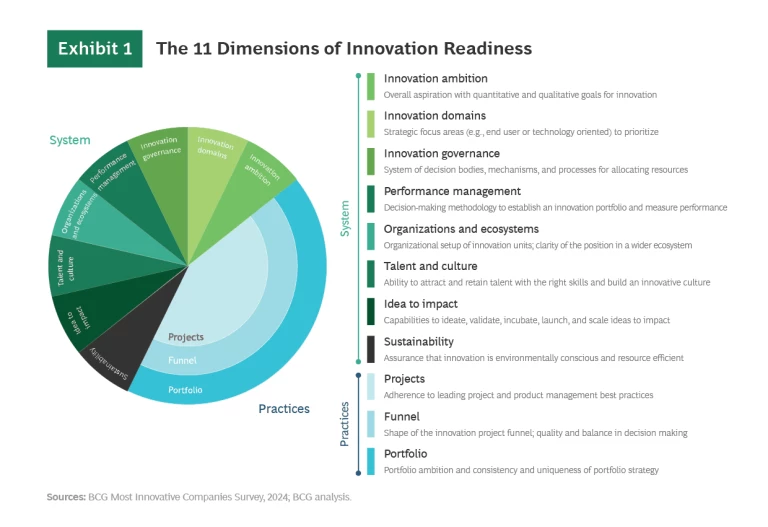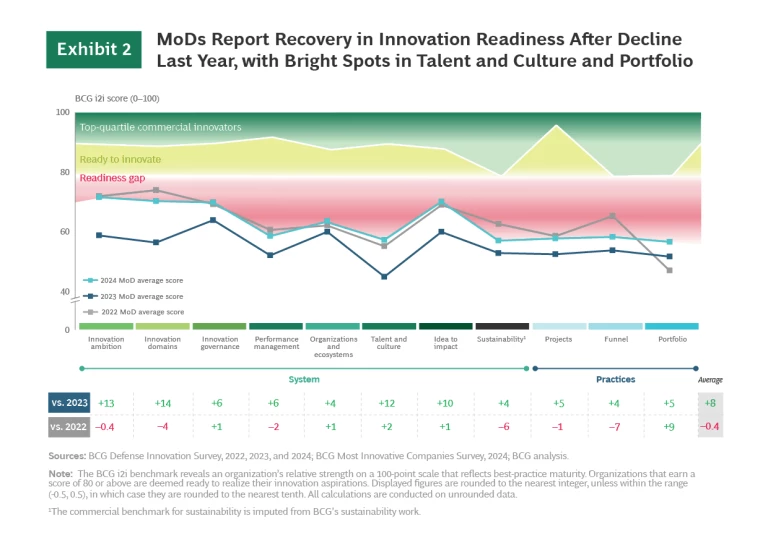Ministries of defense (MoDs) worldwide continue to cite innovation as a critical priority, and they increasingly look to international partnerships with other MoDs to rapidly develop new sources of military advantage. However, partnerships can bring their own set of challenges—and unless they are set up and executed effectively, these programs can fall far short of their objectives.

Since 2021, the Munich Security Conference (MSC) Innovation Board and Boston Consulting Group (BCG) have joined forces to conduct a comprehensive review of global defense innovation readiness. Each year, we survey and interview officials within MoDs, the EU, and NATO to understand the current state of their innovation readiness as gauged by their performance across 11 key innovation dimensions. (See Exhibit 1.)
Our initial study, published in 2022, quantified the defense innovation readiness gap—the gap between ministries' aspirations for innovation and their ability to generate results. The 2023 analysis showed that this gap actually widened.

This year, the defense innovation readiness gap mostly recovered from the drop observed in 2023, with an average increase of 8 points from last year’s results across the 11 readiness dimensions. (See Exhibit 2.) Nevertheless, the survey reveals that considerable gaps remain between MoDs and the 80-point readiness threshold. Specifically, we identified gaps of 20 points or more in six dimensions, with the largest in portfolio management (23 points), talent and culture (22 points), and project management (22 points). The findings from this year’s new study appear in more complete detail in our full report.
A primary lever that MoDs are using to close the defense innovation readiness gap is partnership with other MoDs, as well as collaborations with industry, academic organizations, and innovation accelerators. Our data shows both the progress made since last year and the challenges that remain in making partnerships deliver:
- 90% of respondents have defined policies, processes, and mechanisms to leverage innovation from other countries through partnerships (up from 63% last year). Yet only 7% report that they are effectively implementing these policies, processes, and mechanisms to drive impact.
- 46% say that decision-making bodies do not make decisions effectively and lack paths to resolve issues, and 41% do not agree that the governance structures for their innovation partnerships are established effectively.
- 40% report a lack of interoperability standards with their key mission partners.
Accordingly, in this year’s Defense Innovation Readiness Gap report, we focus on five concrete actions that MoDs can take to enhance their innovation partnerships and drive tangible outcomes:
- Build on unique capabilities. Distribute workshare and value on the basis of partners’ differentiated strengths.
- Establish an orchestrator-led governance model. Designate a single party with primary responsibility, and build a supporting control tower.
- Cultivate open and effective cooperation. Establish regular information exchange, IP sharing, and modular open systems to maximize benefits for all partners.
- Build resiliency into innovation processes. Team with users and technical experts to validate timelines and embed risk-management best practices.
- Make industry and civil society organizations a force multiplier. Leverage the private sector, nontraditional players, academia, and nongovernment agencies to access next-generation technologies and top talent.
Together, these five actions can help MoDs create more efficient and effective innovation partnerships.



